reify, reification - To treat an abstraction as if it had concrete or material existence. Reification is what the viewer experiences in treating an abstraction as if it had concrete or material existence.
(pr. REE-ə-fi:)
Also see trompe l'oeil and universal artwork.
reinforced concrete - Concrete with increased tensile strength produced by iron or steel mesh or bars embedded in it. Also called ferroconcrete.
relative humidity - The proportion of actual moisture in the air to the maximum amount possible at a specified temperature. It is stated as a percentage, with 100% being air fully saturated with water vapor. Control very important in art conservation because when relative humidity is either too high, too low, or changes dramaticly, relative humidity can damage many types of artworks. Organic materials absorb or give off moisture in a continuous attempt to achieve equilibrium with the atmosphere. These materials tend to be more stable in a moderate relative humidity (45-55%), a condition rarely present in normal exterior or interior environments. Inorganic materials usually are not affected by relative humidity levels unless they contain salts or are otherwise unstable. Metals, however, are best preserved at low relative humidity. Serious damage can occur when materials are subjected to dramatic, sudden changes in relative humidity over short periods. Prolonged exposure of organic materials to relative humidity above 60-65% will encourage the growth of molds and fungi.
Also see climate control, condensation, foxing, hygrothermograph, museum, silica gel, and thymol.
release agent - A substance applied to the inside surfaces and seams of a mold to prevent the casting from adhering to the mold; also variously known as a separator, parting agent, or parting compound. A release agent for casting plaster in a mold may be a thin clay slip, or several applications of a soft liquid soap, petroleum jelly, or a thin oil. To permit clay to separate from a mold, apply either powdered chalk or talc as a release agent.
relic - An object or a custom that remains from a previous time or culture. Something prized for its age or historic interest, especially something that can be linked to a particular person, place or event. Or, an object of religious veneration, especially a piece of the body of a holy person, or of an object associated with one. In the Christian tradition, relics were especially important throughout the Middle Ages. In the tradition of the Roman Catholic Church, relics of the saints and other holy persons, as well as bits of the crown of thorns, the true cross, and other objects associated with holy persons, are prized for those associations. A container for a relic is a reliquary, also called a feretory. A feretory is also the area of a church in which relics are kept.
Material culture and other objects are also called relics when they have survived a long time. Some such objects used by educators to help students to understand other cultures and real life situations might also be called realia. A library's collection might contain a piece of realia for its association with a great author, or with an event. Imagine the thrill of possessing Shakespeare's eraser, or the applecore from the Garden of Eden!
(pr. RE-lək)
Examples:

Bone of Buddha Kasyapa in a reliquary
of concentric golden vessels,
the Great Stupa of the Universal Compassion, Bendigo, Australia.
This very small piece of bone came from Lama Zopa Rinpoche's
relic collection. Buddha Kasyapa
is the Buddha prior to Shakyamuni Buddha. In the Maha Padana
Sutra of the Digha Nikaya, the present Buddha gives an account
of the six previous Buddhas beginning with Vipassi, then Sikhi,
Vessabhu, Kakusanda, Konagama and Kasyapa.

Byzantium, The Cambrai Madonna, c. 1340, Metropolitan
Museum of Art. About a hundred years after it was produced, Canon
Fursy de Bruille acquired this icon
in Rome. He was told that it was a holy relic: it had been painted
by St. Luke himself. In 1440, the canon gave the painting to
the Cathedral of Cambrai, France, where thousands of pilgrims
saw it. The image shows Jesus
squirming in his mother's arms. Mother and child, doleful and
shy, turn slightly toward us, as if they are watching or waiting
for something. The Cambrai Madonna conforms to a type, "the
Virgin of Tenderness," an invention of the late Byzantine
era. See Byzantine
art and Madonna.
Quote:
"These unanticipated acquisitions
are referred to in the trade [by librarians] variously as personal
effects, ephemera, artifacts, memorabilia, and perhaps most evocatively,
realia."
Lev Grossman, "Catalog This: Dante's dust, Poe's hair, Taft's
underwear. Oh, my, what's a librarian to do?" April 14,
2002, New York Times, Education Life section, page
26.
Also see artifacts, cathedral, found objects, kitsch, memorabilia, and reliquary.
relief printing - Printing methods in which a block of wood, linoleum or some other material's surface is carved so that an image can be printed from it — un-carved areas receiving ink which transfers to another surface when the block is pressed against it. Block printing.
reliquary - A container or receptacle, such as a coffer or shrine, used to keep or display sacred relics, and usually made of a richly decorated, precious material. Reliquaries have been produced by numerous cultures. In the Christian tradition, they were especially important throughout the Middle Ages. Another name for reliquary, though much less common, is feretory. Feretory is also the area of a church in which relics are kept.
(pr. RE-lə-kwə-ree)
Examples of reliquaries:

Germanic Holy Roman Empire, Köln, Domed
Reliquary of the Guelf Treasure, c. 1175, Industrial
Art Museum, Berlin. See German art.

France, Figure Reliquary of St. Stephen, late
12th century, wood, silver gilt,
gemstones, bloodstone, glass, height
42.5 cm, Hermitage Museum, St. Petersburg, Russia. See French
art.


Byzantine, 14th century, Reliquary Box
with Scenes from the Life of John the Baptist, tempera
and gold on wood, 9 x 23.5 x 9.9 cm (3 5/8 x 9
1/4 x 4 inches), Cleveland Museum of Art, OH. Here are enlargements
of two views of this reliquary — first and second. See Byzantine
art.
![]()
Italian, Savoy, Reliquary Head of St. Theobald, 14th
century - 15th century, silver, silver gilt,
paste jewel, 14 x 15 x 7 1/2 inches, Minneapolis Institute of
Arts.

Hans Multscher (German, c. 1400-1467),
Reliquary
Bust of a Female Saint, c. 1460, bronze,
height 12 5/8 inches (32 cm),
Frick Collection, NY.

Austrian, Augsburg, mid-17th century, Reliquary
with a Nail from the Cross, gold,
silver-gilt,
partially enamelled
and painted, painted brass,
gemstones, rock crystal, pearls,
glass, height
79.6 cm, Kunsthistoriches Museum, Vienna. See nail.
![]()
Kota, Africa, Gabon, Reliquary figure, 19th century, wood,
copper, 22 x 11 5/8 x 2 inches, Minneapolis
Institute of Arts. See African
art.

Fang peoples, Africa, Gabon, Reliquary Head (Nlo Bieri), 19th-20th
century, wood, metal,
oil, height
18 5/16 inches (46.5 cm), Metropolitan Museum of Art, NY. See
African art.
A quote about relics:
"Art among a religious race produces
relics; among a military one, trophies; among a commercial one,
articles of trade."
Henry Fuseli (1741-1825), English Romantic painter.
Related links:
The Glossary of Medieval Art and Architecture defines reliquary and provides an illustration.
The Topkapi Palace Museum in Istanbul, Turkey, has a wonderful Chamber of Relics. The web page about it displays photos of its collection of beautifully encased relics from early Islamic, including Mohammad's swords, his holy mantle, hair from his beard, his footprint, one of his teeth, among other things.
Also see gem, memorabilia, vessel, votive, Wunderkabinett and Wunderkammer.
remarque - In printmaking, most often in etchings, a sketch originally made by the artist on the margin of his plate to test his tools, often to test the degree of the mordant's biting before immersing the entire plate in the acid bath. Because such remarques were originally intended to be scraped or burnished away before the final edition of the plate is printed, a print with a remarque is often called a remarque proof. In the nineteenth century such remarques came to be so valued that they were often retained as part of the finished print. The subjects of these little drawings typically relate in some way to the larger image. The practice greatly fell out of use in the twentieth century.
(pr. rə-MAHRK)
Example:
Theophile Alexandre Steinlen (French, ), La Gloire,1915, color lithograph on heavy rice paper, signed in pencil and numbered 96/100 by the artist, 12 x 16 inches, Annalie Gallery. Made during World War I, this print depicts four women mourning over a soldier's flag-draped coffin. The remarque in the lower right margin of La Gloire is a drawing of the head and shoulders of a soldier.
Also see edge, margin, marginalia, and palimpsest.
render - To represent in a drawing or painting, especially in perspective. Also, to create an interpretation of another artist's work, perhaps in another form. Also, a coat of plaster, cement, or concrete which is applied to raw brick, stone, etc., or to apply such a coat.
rendering and rendition - A depiction or an interpretation. Also, a drawing in perspective of a proposed structure. (Rendering can be used either as a noun or as a verb.)
Also see Index of American Design and render.
repetition - Closely related to harmony, a principle of design, this term refers to a way of combining elements of art so that the same elements are used over and over again. Thus, a certain color or shape might be used several times in the same picture. Repetition also can contribute to movement and rhythm in a work of art.
Quote:
Also see boredom, change, movement, and pattern.
replica - A copy. The verb form is replicate. More often used for copies of technological and other manufactured objects than for works of art.
Examples:

![]()

![]()
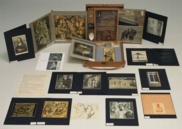
Marcel Duchamp, Box in a Valise (From or by Marcel Duchamp or Rrose Sélavy), 1935-41, leather valise containing miniature replicas, photographs, color reproductions of works by Duchamp, and one "original" drawing [Large Glass, collotype on celluloid, 7 1/2 x 9 1/2 inches (19 x 23.5 cm)], 16 x 15 x 4 inches (40.7 x 38.1 x 10.2 cm), Museum of Modern Art, NY. See Dada.
Also see appropriation, collectible, counterfeit, facsimile, forgery, full-scale, likeness, mirror, paint-by-number, representation, reproduction, simulacrum, and tracing.
replicate - See replica and reproduce.
repoussé - The method of producing metal relief by hammering and/or punching a sheet of metal from the back. The metal is usually hammered into a prepared mold, then final details are engraved onto the front of the relief. Materials raised by repoussé can either stop at having embossed surfaces, or they can be taken beyond such a relief stage to result in an object that must be seen in the round. Because it comes to us in a past tense form in French, it is inappropriate to add -ed in English usage.
(pr. RE-poo-SAY)
Examples:
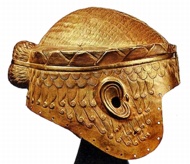
Mesopotamia, Royal Cemetary at Ur, Gold Helmet of King Meskalamdug, c. 2400 BCE, repoussé gold, height 22 cm, greatest diameter 26 cm. The decoration of the helmet simulates the king's crown, hair, and ears. Holes drilled along the lower edges enabled the attachment of an inner helmet. This is one of many Mesopotamian objects that have recently been lost or stolen from Iraq's museums, and have yet to be recovered. The Oriental Institute of the U of Chicago has posted a database of treasures that have been lost or stolen from Iraq. See arms and armor.

Etruria, Chariot, c. 550-525 BCE,
bronze, ivory, height
51 9/16 inches (130.91 cm), Metropolitan Museum of Art, NY. The
bronze repoussé reliefs on
the chariot box illustrate three episodes in the life of a warrior
or hero, perhaps Achilles. See Etruscan
art.

Hellenistic, Phiale, c. 300 BCE, repoussé gold, diameter 23 cm, Metropolitan Museum of Art, NY. In the center of this phiale is a large boss representing the omphalos, the mythic navel of the universe. A radial pattern of acorns and bees, each symbolizing the earth's "victual in plenty," as described by Hesiod. See Hellenistic art.
South America, Central Andes, North Coast, Chímu-Lambayeque, Pair of Earspools, Late Intermediate Period, 1000-1470 CE, repoussé gold-copper alloy and silver alloy, diameter of disk 3 x 4 7/16 inches (7.5 x 11.1 cm diameter of disk), Michael C. Carlos Museum, Emery U, Atlanta, GA. See jewelry and Pre-Columbian art.

Attributed to Khorasan, Eastern Iran, Seljuq,
Brass Ewer, c. 1180-1210, repoussé
brass, inlaid
with silver
and bitumen, height
15 3/4 x 7.5 inches (40 x 19.1 cm), Metropolitan Museum of Art,
NY. See ewer and Islamic art.

Nepal, Aureole of a shrine, 1600-1700, gilt
copper repoussé, Asian Art
Museum, San Francisco, CA. See aureole
and Buddhist art.

India, Maharashtra or Karnataka, South Asia, Mask of Shiva, 18th century, repoussé silver, 9 7/8 x 6 7/8 x 2 1/2 inches (25.08 x 17.46 x 6.35 cm), Los Angeles County Museum of Art. See mask.
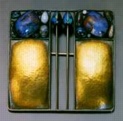
Josef Hoffmann (Austrian, 1870-1956) for
Wiener Werkstätte, Square Brooch, silver lattice, repoussé gold, and opal, c. 1905. See Art Nouveau, jewelry, opalescence, and secession.
Also see boss, burgundy pitch, copper, dent, emboss, pitch, raising, steel sheet gauges, and toreutics.
represent and representation - To stand for; symbolize. To depict or portray subjects a viewer may recognize as having a likeness; the opposite of abstraction. A representation is such a depiction.
Quote:
Other resources concerning representation:
Also see analogy, appropriation, copy, counterfeit, facsimile, fake, forgery, full-scale, homage, iconography, marbling, metaphor, mirror, positive, posthumous, rebus, replica, reproduction, scale, simile, simulacrum, simulation, and statue.
reproduction - The act of reproducing; copying; creating a facsimile. The product of the act of reproducing, especially when it is significantly faithful in its resemblance to the form and elements of the original.
A quotation about reproduction:
Also see analogy, appropriation, cast, copyright, counterfeit, droit moral, ersatz, fake, forgery, full-scale, kitsch, likeness, mirror, moiré, originality, paint-by-number, poster, print, replica, representation, simile, simulacrum, and simulation.
Republic of China or Republican period of Chinese art - A Chinese period of history which began in 1912. Although the Republic of China was driven from what is now called China (People's Republic of China) in 1949 by Communist revolutionaries led by Mao Tsetung, it has continued to flourish on the island of Taiwan (Formosa), as an independent country, also called Nationalist China. When General Chiang Kai-shek (1887-1975) resigned as president of Nationalist China in January 1949 and fled to Taiwan that May, he took with him a national art collection that was kept in crates for years as he and his followers clung to the ever-diminishing hope that they would someday take it back to Beijing. This collection became the core of what is today the National Palace Museum.
Example:

Zhang Yuan (Chinese), Autumn Flowers, 1948, ink and color on paper, Phoenix Art Museum, AZ. See botanical and nature.
Related links:
research - See action research, art advocacy, art therapy, bias, creativity, effort, motivation, multiple intelligence theory, and science and art.
reserve column - In ancient Egyptian and Etruscan domed tombs, a column that is hewn from the living rock and serves no supporting function.
Also see architecture and structure.
Resettlement Administration (RA) - An agency of the U.S. government's in the Agriculture Department during the Great Depression of the 1930s and 1940s. It was a part of the federal bureaucracy which administered New Deal art programs. It later became the Farm Security Administration (FSA).
Examples of work produced for the RA:
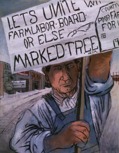
Ben Shahn (American, 1898-1969), for the
Resettlement Administration (RA), Lest We Forget, 1937, gouache and watercolor in bound volume, Franklin
D. Roosevelt Library, National Archives and Records Administration.
See social realism.

Ben Shahn, for the Resettlement Administration
(RA), Years
of Dust, 1937, photolithograph, Franklin D. Roosevelt
Library, National Archives and Records Administration.
resin - A natural substance secreted by plants (mostly
trees),  which is transparent
to translucent yellow or brown,
such as copal, rosin, and amber, used principally in lacquers,
varnishes, inks,
adhesives, synthetic
plastics, and turpentine.
Also, synthetic plastics, including thermoplastic
materials such as polyvinyl,
polystyrene, and polyethylene,
and thermosetting materials
such as polyesters, epoxies,
polyurethane, and silicones
that are used with fillers,
stabilizers, pigments, and
other components to form plastics.
which is transparent
to translucent yellow or brown,
such as copal, rosin, and amber, used principally in lacquers,
varnishes, inks,
adhesives, synthetic
plastics, and turpentine.
Also, synthetic plastics, including thermoplastic
materials such as polyvinyl,
polystyrene, and polyethylene,
and thermosetting materials
such as polyesters, epoxies,
polyurethane, and silicones
that are used with fillers,
stabilizers, pigments, and
other components to form plastics.
(pr. RE-zən)
trademarks for resins
|
trade name |
manufacturer, country |
| Bakelite ® (PF) | BXL, UK |
| Beetle ® (UF) | BIP, UK |
| Ciba Geigy ® (PF) | CIBA Geigy, UK |
| Cymel ® (MF) | Cyanamid, USA |
| Formica Laminate ® (MF) | De la Rue, UK |
Also see burgundy pitch, encaustic, toluene, trademark (®), and wood.
resist - A substance which protects a surface from receiving paints, inks, or dyes. Waxes are commonly used as a resist to the dyes used in batik.
(pr. rə-ZIST)
Also see beeswax, blockout, clean up, lithography, paraffin, and solvent.
resolution, image - In digital imaging, the number of pixels, in both height and width, making up an image. The higher the resolution of an image, the greater its clarity and definition. The resolution for Web graphics is typically 72 dpi, way too low for print purposes. If the artwork is linework (no shades or tints, only solid colors), the resolution of a graphic must match the resolution of the final printer. If that isn't known, then saving the artwork at 600 dpi is likely to be safe.
Related link:
Also see aliased and anti-aliased, definition, moiré, and output resolution.
resolution, output - The number of dots per inch, dpi, used to display a digital image on a monitor or in print. The resolution for Web graphics is typically 72 dpi, way too low for most print purposes.
Related link:
Also see moiré and image resolution.
resonance - A prolonged, subtle, or stimulating effect beyond the initial impact. Something resonates either when it stays in one's memory, or when its juxtaposition to another thing has such an effect.
(pr. RE-zə-nəns)
Also see aesthetic experience, edge, frisson, and meaning.
respond - In architecture, an engaged column, pilaster, or similar structure that projects from a compound pier or some other supporting device or is joined to a wall and carries one end of an arch, often at the end of an arcade. A nave arcade, for example, may have nine pillars and two responds.
restoration - See art restoration.
retable - Structural and decorative elements of an altarpiece, which may include the frames for painted panels, shelves, ornaments, etc.
(pr. REE-tay-bəl or RE-tə-bəl)
Related link:
The Glossary of Medieval Art and Architecture defines retable and provides an illustration.
retablo - Spanish for retable. The example below, because it depicts a saint, is a santo retablo. Santos are votive pictures or sculptures made or used by Christians of Hispanic heritage. They are not images intended to be physically descriptive of a person, but are seen as the symbolic embodiment of an ideal.
(pr. rə-TAH-bloh)
Example:

José de Gracia Gonzales (American,
New Mexican santero), San Jose,
retablo, c. 1850-75, painted wood,
Millicent Rogers Museum, Taos, NM.
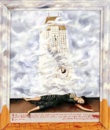
Frida Kahlo (Mexican, 1907-1954), El suicido de Dorothy Hale (The Suicide of Dorothy Hale), 1939, oil on Masonite panel with painted frame, Phoenix Art Museum, AZ. The subject is Dorothy Hale, a beautiful society woman who became despondent and threw herself from the window of her New York apartment. Kahlo describes the horrible event in the inscription, which is written in Spanish. The English translation is: "In New York City on the 21st of October 1938, at 6:00 in the morning, Dorothy Hale committed suicide by throwing herself from a very high window in the Hampshire House. In her memory [...], this retablo was executed by Frida Kahlo." Part of the third line has been erased. Another part of the painting also was changed: an angel once appeared at the top. These erasures were made in response to the violent reaction from Clare Boothe Luce, who commissioned the work. See memorial, Mexican art, and feminism and feminist art.
Also see angel, Chicano art and Chicana art, ex voto, milagro, and santero.
retina - Anatomically essential to seeing, this is a delicate, multilayered, light-sensitive membrane lining the inner eyeball, opposite the eye's lens. It is a sheet of photoreceptors (light receptors), millions of specialized brain cells (neurons) which are excited by light. These light receptors are differentiated into neurons called rods and cones, which are connected by the optic nerve to the brain.
The retina is much like a sheet of film inside an analog camera, but it has a hole in it known as a blind spot. At this location, neurons pass as a bundle through the photoreceptor sheet to form the optic nerve, which carries information from the eye to the rest of the brain. Here there are no photoreceptors, and hence the brain gets no information from the eye about this particular part of the picture of the world.
(pr. RE-tə-nu)
Related resources:
Also see afterimage, binocular vision, colorblind, gestalt, night blindness or nyctalopia, Op Art, ophthalmology, optical, optical mixing, perception, peripheral vision, photography, pupil, refraction, retinal art, stereoscopic vision, and vitreous humor.
retinal art - As originated by Marcel Duchamp (French-American, 1887-1968), this refers to art whose appeal is mainly or exclusively to the eye rather than to the mind.
Also see Dada, meaning, Op Art, optical, and sight.
retouch - To make corrections on artwork. In photography, eliminating or altering parts of a picture.
Also see art conservation, art criticism, art restoration, and assessment.
retrospective - An exhibit that shows a large number of works over time by a living artist. This allows a viewer to study the development of the artist's style, use of techniques, and choice of subjects, along with other aspects of the work. Retrospectives have traditionally been arranged chronologically — early career, middle career, late career — but may also be arranged thematically.
Also see catalogue raisonné.
reversals - Perceiving, reading, and writing words and letters backwards. For example, "cat" appears as "tac", and "d" as "b." A common trait among dyslexics.
reverse - The rear or back view of an object. To turn an object backward, or to order a number of things in an opposite direction. Often refers to the back side of a two-sided object, such as a coin, a medal, a seal, or a panel which has a painting on each side. The opposite of reverse is obverse. The front and rear sides of works on paper are more often referred to as recto and verso.
Also see align and alignment, graphic design, invert, mirror, negative, numismatics, and reversible.
reversible - Having the ability to be reversed or inverted. A reversible image is one that can be seen as right-side-up even when turned upside-down, or as frontward when it is backward or flipped over.
In art conservation, such actions as inpainting or relining are said to be reversible when they are done in such a way that they can be removed or undone without harming the rest of the work.
Examples of reversible images:

 Giuseppe
Arcimboldo (Italian, c. 1530 - 1593), The Vegetable Gardener,
a reversible oil painting,
Museo Civico, Cremona.
Giuseppe
Arcimboldo (Italian, c. 1530 - 1593), The Vegetable Gardener,
a reversible oil painting,
Museo Civico, Cremona. Turned one way, the painting is a still life: a bowl of vegetables.
When inverted, it caricatures the head of a man wearing a cap — The
Vegetable Gardener.

Jon Mac (British, contemporary), Topsy Turvys, c. 2003. This is the
cover of a book on which seven of the artist's paintings of reversible
heads are reproduced. Each of the
sort of reversible pictures in this book, made especially for
the amusement of children, is traditionally
known as a "topsy-turvy."
Quote:
Also see anamorphic art, distortion, incongruity, optical illusion, and perception.
https://inform.quest/_art